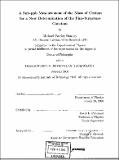| dc.contributor.advisor | David E. Pritchard. | en_US |
| dc.contributor.author | Bradley, Michael Patrick, 1971- | en_US |
| dc.contributor.other | Massachusetts Institute of Technology. Dept. of Physics. | en_US |
| dc.date.accessioned | 2005-09-26T19:13:03Z | |
| dc.date.available | 2005-09-26T19:13:03Z | |
| dc.date.copyright | 2000 | en_US |
| dc.date.issued | 2000 | en_US |
| dc.identifier.uri | http://hdl.handle.net/1721.1/28222 | |
| dc.description | Thesis (Ph.D.)--Massachusetts Institute of Technology, Dept. of Physics, 2000. | en_US |
| dc.description | Includes bibliographical references (p. 186-194). | en_US |
| dc.description.abstract | This thesis describes recent single-ion Penning trap mass spectrometry measurements of the mass of atomic Cesium with a relative uncertainty of 2 x 10-10. This measurement reduces the uncertainty on the mass of Cesium by a factor of 100, and removes this uncertainty as a limitation on the accuracy of a determination of the fine-structure constant alpha via a Cesium photon recoil experiment. Removal of this limit should ultimately allow this value of alpha to have a relative accuracy ~1 ppb, which would be comparable to or even better than the most accurate measurement of alpha currently available. This value of alpha will help shed light on the current ~50 ppb discrepancies between values of alpha measured via different routes. In addition to the mass measurement of Cesium, this thesis also describes related mass measurements of atomic Rubidium and Sodium which reduce the uncertainties on these masses by factors - 100, with a view to possible future photon recoil measurements using these species. The measurements were taken using a new Penning trap mass spectrometer constructed by the author and his colleagues. This new spectrometer followed the general design principles of previous MIT ICR Lab Penning trap mass spectrometers, and incorporated a DC SQUID as an ion detector for the first time. This thesis concludes with a discussion of a passive two-coil system designed for shielding magnetic field gradients. These may prove to be the key enabling technology for a future double Penning trap mass spectrometer. | en_US |
| dc.description.statementofresponsibility | by Michael Patrick Bradley. | en_US |
| dc.format.extent | 197 p. | en_US |
| dc.format.extent | 10677646 bytes | |
| dc.format.extent | 10702652 bytes | |
| dc.format.mimetype | application/pdf | |
| dc.format.mimetype | application/pdf | |
| dc.language.iso | en_US | |
| dc.publisher | Massachusetts Institute of Technology | en_US |
| dc.rights | M.I.T. theses are protected by copyright. They may be viewed from this source for any purpose, but reproduction or distribution in any format is prohibited without written permission. See provided URL for inquiries about permission. | en_US |
| dc.rights.uri | http://dspace.mit.edu/handle/1721.1/7582 | |
| dc.subject | Physics. | en_US |
| dc.title | A sub-ppb measurement of the mass of cesium for a new determination of the fine-structure constant | en_US |
| dc.type | Thesis | en_US |
| dc.description.degree | Ph.D. | en_US |
| dc.contributor.department | Massachusetts Institute of Technology. Department of Physics | |
| dc.identifier.oclc | 45294778 | en_US |
